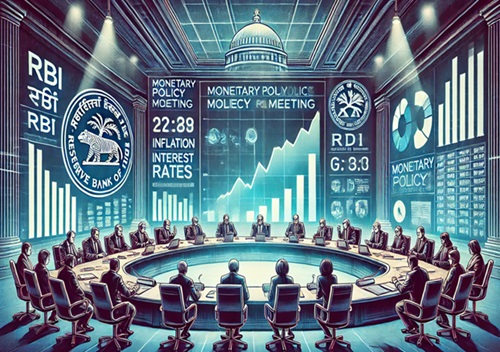Why in the NEWS?
- RBI cut the repo rate by 25 basis points to 6.25%, the first time in five years.

Key Points:
- Many important economic decisions were taken in the Monetary Policy Committee (MPC) meeting 2025 of the Reserve Bank of India (RBI).
- The aim of these decisions is to keep the Indian economy stable, control inflation and accelerate economic growth.
What will you read next in this topic?
- Repo rate cut
- GDP growth rate forecast
- Inflation forecast
- Effect of Repo Rate Cut
- Measures to tackle cyber fraud
- RBI's intervention in the foreign exchange market
- Global economic situation and challenges
- What is Repo Rate?
- What is Reverse Repo Rate?
- What is Bank Rate?
- What is CRR (Cash Reserve Ratio)?
- What is SLR (Statutory Liquidity Ratio)?
Repo rate cut
- The Reserve Bank of India cut the repo rate by 25 basis points (0.25%), bringing it to 6.25%.
- This is the first time in the last 5 years; the last cut was in May 2020.
- The repo rate is the rate at which the RBI lends to commercial banks. Its reduction will allow banks to obtain loans at cheaper rates, which will increase cash flow in the market.
- The main objective of this decision is to make loans cheaper, boost consumption and encourage investment.
GDP growth rate forecast
- The RBI has projected the GDP growth rate to be 6.7% for the financial year 2025-26.
- According to the pre-budget Economic Survey released by the government, the GDP growth rate in 2025-26 can be between 6.3% - 6.8%.
- GDP growth is expected to be 6.4% in 2024-25, which is considered to be the slowest in the last four years.
- Growth rate may come under pressure due to global economic uncertainties, inflation and reduced investment.
Inflation forecast
- RBI has projected retail inflation (CPI) to be 4.2% in 2025-26. This forecast is as follows:
- Inflation forecast for 2024-25: 4.8%
- Quarterly inflation rate for 2025-26:
- Q1 (April-June): 4.5%
- Q2 (July-September): 4%
- Q3 (October-December): 3.8%
- Q4 (January-March): 4.2%
- The RBI governor said that "if the monsoon remains normal, inflation will remain under control."
Effect of Repo Rate Cut
- Repo rate cut will provide relief to borrowers as their EMIs (monthly instalments) will be reduced.
- Banks will get funds at lower interest rates, which will enable them to lend to consumers at cheaper rates.
- Interest rates on home loans, auto loans and personal loans may see a decline.
- This will encourage consumption and investment, which will boost economic activities.
- MSMEs may get financial support at lower rates, which can accelerate industrial growth.
Measures to tackle cyber fraud
- Given the growing scope of digitisation, RBI has taken new steps to curb cyber fraud:
- Additional authentication will be enforced for online international digital payments.
- The domain "bank.in" will be made mandatory for Indian banks and "fin.in" for other financial institutions.
- Cyber security measures will be further tightened to enhance the security and transparency of financial services.
RBI's intervention in the foreign exchange market
- The RBI will intervene in the foreign exchange market to maintain the stability of the Indian rupee.
- Instead of controlling the currency exchange rate, the focus will be only on reducing excessive volatility.
- Keeping in mind the global financial uncertainties, RBI can use foreign exchange reserves to reduce the pressure on the Indian rupee.
Global economic situation and challenges
- The trade war between the US, China, Canada and Mexico is likely to escalate.
- The strength of the dollar and volatility in global financial markets may put pressure on the Indian rupee.
- Changes in interest rates in the US and the policies of the European Central Bank (ECB) can have an impact on the Indian economy.
- Geopolitical tensions and climate change can pose new challenges to the Indian economy.
What is Repo Rate?
- Repo Rate is the interest rate at which the Reserve Bank of India (RBI) provides short-term loans to commercial banks.
- Whenever banks need money, they borrow from RBI and pledge government bonds or securities against it.
Importance of Repo Rate
- To control inflation:
- When inflation is high, RBI increases the repo rate so that banks get expensive loans and money flow in the market reduces.
- When there is an economic slowdown, RBI decreases the repo rate so that banks get cheaper loans and they can lend to customers at a lower interest rate.
- Effect on interest rates:
- Changes in the repo rate directly affect the interest rates of home loans, car loans, personal loans and business loans.
- Main tool of monetary policy:
- This is the most effective tool of RBI's monetary policy, through which it controls liquidity in the market.
What is Reverse Repo Rate?
- The reverse repo rate is the interest rate at which the Reserve Bank of India (RBI) borrows their excess cash from commercial banks.
- When banks have excess money and they deposit it with the RBI, the interest they get on it is called the reverse repo rate.
Importance of Reverse Repo Rate
- Controlling liquidity in the market:
- When there is too much cash in the market, the RBI increases the reverse repo rate, so that banks deposit their money with the RBI and the flow of money in the market decreases.
- If the economy needs cash, the RBI reduces the reverse repo rate, which encourages banks to lend money instead of depositing it with the RBI.
- Control over Inflation:
- If inflation is high, the reverse repo rate is increased so that excess money can be removed from the market.
- If economic growth is to be promoted, the reverse repo rate is reduced so that banks lend more and investment and spending increase.
- Relation with Repo Rate:
- The reverse repo rate is always lower than the repo rate because it is the interest paid to banks, while the repo rate is the interest rate at which banks borrow from the RBI.
What is Bank Rate?
- The bank rate is the interest rate at which the Reserve Bank of India (RBI) provides long-term loans to commercial banks.
- This is the rate at which RBI gives loans to banks without any security (collateral).
Importance of Bank Rate
- Major tool of monetary policy
- RBI controls money supply and inflation in the economy by controlling the bank rate.
- When inflation rises, RBI increases the bank rate, making loans expensive and reducing the flow of money in the market.
- When there is a need to boost economic activity, RBI reduces the bank rate, allowing banks to borrow at a cheaper rate and provide more money to the market.
- Difference from Repo Rate
- The repo rate is for short-term borrowing and banks pledge government securities.
- The bank rate is for long-term borrowing and there is no collateral.
- Usually, the bank rate is higher than the repo rate.
What is CRR (Cash Reserve Ratio)?
- CRR is the minimum cash amount that all commercial banks are required to keep with the RBI as a certain percentage of their total deposits (Net Demand and Time Liabilities - NDTL).
Objective of CRR
- To control the money supply in the market.
- Controlling inflation and maintaining financial stability.
- Affecting the lending capacity of banks.
What is SLR (Statutory Liquidity Ratio)?
- SLR is the minimum amount that commercial banks are required to keep as a certain percentage of their total deposits (NDTL) in the form of government securities, gold, or cash.
Objective of SLR
- To ensure liquidity in the banking system.
- To prevent banks from lending too much money unnecessarily.
- To maintain the demand for government bonds.
Key Differences between CRR and SLR
|
Basis
|
CRR (Cash Reserve Ratio)
|
SLR (Statutory Liquidity Ratio)
|
|
Definition
|
Banks are required to keep a portion of their deposits as cash with the RBI.
|
Banks are required to maintain a portion of their deposits in government securities, cash, or gold.
|
|
Place of Reserve
|
Kept only with the RBI.
|
Banks can maintain it themselves.
|
|
Impact
|
Directly affects the lending capacity of banks.
|
Ensures that banks keep some assets secure.
|
|
Interest Earned
|
Banks do not earn any interest on CRR.
|
Banks can earn interest on government bonds.
|
|
Monetary Control
|
Controls cash flow in the economy.
|
Maintains liquidity in the banking system.
|
|
Q. Repo Rate refers to?
(a) The rate at which RBI borrows money from banks
(b) The rate at which RBI lends short-term money to commercial banks
(c) The rate at which banks lend money to customers
(d) The rate at which customers deposit money in a bank
|



